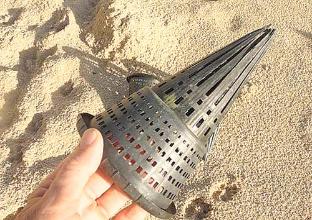Published in the Ocean Watch column, Honolulu Star-Advertiser © Susan Scott
September 13, 2010
 Cowry snails and hagfish traps don’t have much in common, but after I wrote about them in separate columns last month (Aug. 9 and 16), the two subjects have been competing for space in my e-mail inbox.
Cowry snails and hagfish traps don’t have much in common, but after I wrote about them in separate columns last month (Aug. 9 and 16), the two subjects have been competing for space in my e-mail inbox.
About half the cowry- related letters informed me that my statement that cowries are smaller these days because of overcollecting is wrong. I agree. The statement doesn’t even make sense because cowries grow to their tallest and longest early in development, and get thicker with age.
What I meant to write is that Hawaii’s tiger cowry snails are uncommon due to overcollecting. This is the separate website-posted opinion of three local author-photographer-divers who, combined, have spent thousands of hours underwater in Hawaii. I know these people, and if they think tiger cowries are more difficult to find in Hawaii’s waters now than they were in the past, they would know.
The rest of the cowry e-mails had to do with shell collecting, some readers explaining that they no longer kill snails for their shells, others justifying why they do.
The subject strikes nerves because the two camps strongly disagree. But another cowry snail I once knew struck some funny bones.
Years ago, my friend kept a saltwater aquarium for invertebrates, and in it she had a Cypraea moneta. This 1- to 1.5-inch-long cowry has a cream-colored shell and a beautiful zebra-striped mantle. Common throughout the tropical Indo-Pacific (but uncommon in Hawaii), C. moneta is known as the money cowry because people in some countries once used it for money.
When my friend’s mother visited from the mainland, she saw the lovely little cowry and asked what kind it was.
“The species is moneta,” her daughter said.
“Juanita?” the mother said. “What kind of name is that for a snail?”
Since then, money cowries have always been Juanitas to me.
And now hagfish traps on the beach will always symbolize conservation efforts to me.
Several readers wrote me “aha” e-mails upon learning that those black, plastic cones we find on our beaches are hagfish trapdoors designed to break free from lost traps, preventing the traps from ghost fishing.
“Thank you for showing that fishermen are practicing responsible fishing methods,” a Big Island angler wrote, “and bringing light to the fact that not all marine debris is bad.”
In an effort to identify marine debris, a federal fisheries worker in Seattle is putting together a pictorial book about fishing-related gear lost at sea, and asked for permission to use the hagfish trap photo I shot for that column (pictured at left).
I was happy to share the picture, and also shared the story that goes with it. To take the photo, I brought two cleaned hagfish trapdoors from my home to the beach, and laid them in the sand near my feet. As I chatted with some neighbors, conscientious beach walkers picked up those traps and threw them away — twice! After retrieving the trapdoors from the trash the second time, I shut up and took my pictures.
Such active whisking away of beach trash means to me that publicity about marine debris is having a positive effect. More people are aware of the problem and are doing their part to help.
In sharing my marine experiences in this column, I do my best to use reliable information and informed opinions. Still, I don’t always succeed in reporting them correctly. To all who take time to e-mail me, thank you for helping me get it right.